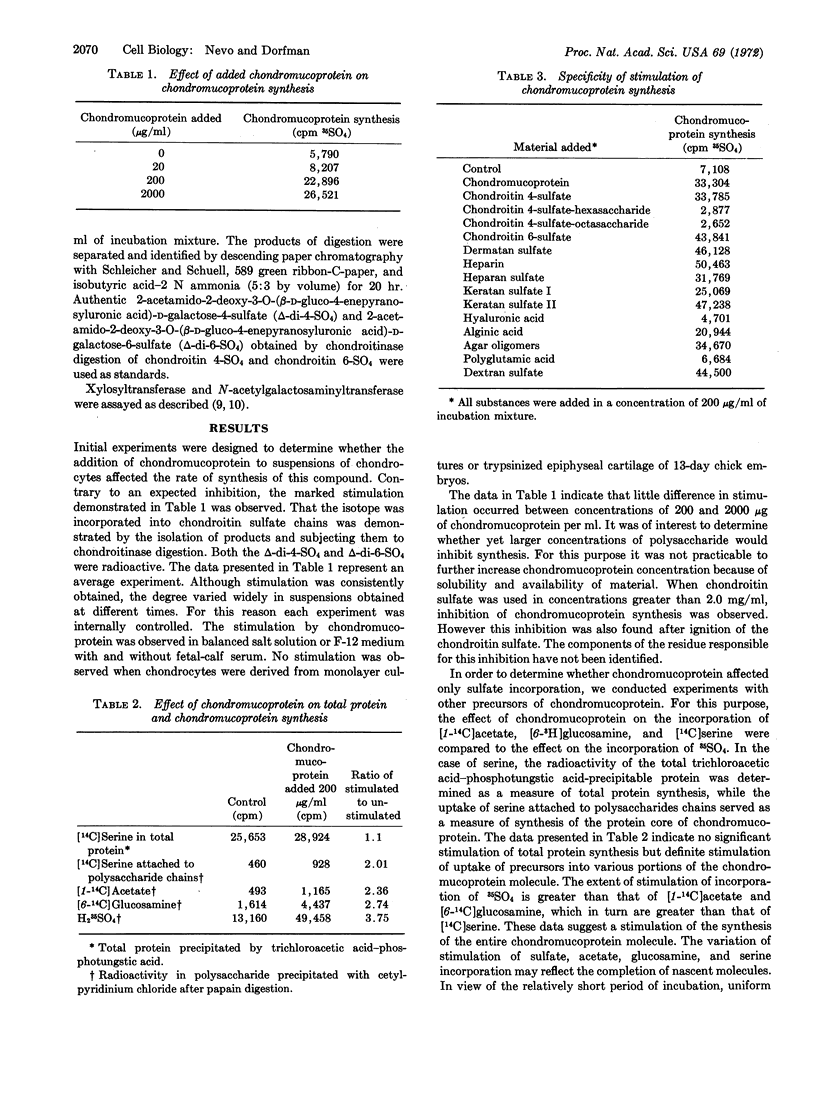Abstract
Chondrocytes in suspension culture preserve their differentiated state, as expressed by a high rate of chondromucoprotein synthesis. Purified chondromuco-protein added to a suspension of cultured embryonic epiphyseal cartilage cells stimulates the rate of synthesis of chondromucoprotein at concentrations up to 2 mg/ml. The stimulation involved synthesis of the entire molecule since incorporation of labeled serine (into core protein), glucosamine, acetate, or sulfate was increased. Neither the amount of synthesis of total protein nor that of collagen was increased. No elevation of xylosyltransferase and N-acetylgalactosaminyltransferase activities was observed. The stimulation was produced by several other polyanionic substances. No evidence was found of the entry of chondromucoprotein into chondrocytes under the conditions of the experiments. Mild trypsinization lowered the response to added chondromucoprotein and decreased the endogenous rate of chondromucoprotein synthesis. Incubation of cells after trypsinization results in restoration of the rates of chondromucoprotein synthesis. The endogenous, as well as the stimulated, rate of chondromucoprotein synthesis varied with the density of chondrocytes in culture. It is suggested that the rate of chondromucoprotein synthesis may be partially controlled by cell surface receptors.
Keywords: cultured chondrocytes, phenotypic expression, cell density
Full text
PDF



Selected References
These references are in PubMed. This may not be the complete list of references from this article.
- Benda P., Lightbody J., Sato G., Levine L., Sweet W. Differentiated rat glial cell strain in tissue culture. Science. 1968 Jul 26;161(3839):370–371. doi: 10.1126/science.161.3839.370. [DOI] [PubMed] [Google Scholar]
- Bronk B. V., Dienes G. J., Johnson R. A. Cooperative regulation of cellular proliferation by intercellular diffusion. Biophys J. 1970 Jun;10(6):487–508. doi: 10.1016/S0006-3495(70)86315-9. [DOI] [PMC free article] [PubMed] [Google Scholar]
- Cuatrecasas P. Properties of the insulin receptor of isolated fat cell membranes. J Biol Chem. 1971 Dec 10;246(23):7265–7274. [PubMed] [Google Scholar]
- Daughaday W. H. Sulfation factor regulation of skeletal growth. A stable mechanism dependent on intermittent growth hormone secretion. Am J Med. 1971 Mar;50(3):277–280. doi: 10.1016/0002-9343(71)90214-2. [DOI] [PubMed] [Google Scholar]
- De Robertis E. Molecular biology of synaptic receptors. Science. 1971 Mar 12;171(3975):963–971. doi: 10.1126/science.171.3975.963. [DOI] [PubMed] [Google Scholar]
- Dunham P. B., Hoffman J. F. Partial purification of the ouabain-binding component and of Na,K-ATPase from human red cell membranes. Proc Natl Acad Sci U S A. 1970 Jul;66(3):936–943. doi: 10.1073/pnas.66.3.936. [DOI] [PMC free article] [PubMed] [Google Scholar]
- Horwitz A. L., Dorfman A. The growth of cartilage cells in soft agar and liquid suspension. J Cell Biol. 1970 May;45(2):434–438. doi: 10.1083/jcb.45.2.434. [DOI] [PMC free article] [PubMed] [Google Scholar]
- Inbar M., Sachs L. Structural difference in sites on the surface membrane of normal and transformed cells. Nature. 1969 Aug 16;223(5207):710–712. doi: 10.1038/223710a0. [DOI] [PubMed] [Google Scholar]
- Jackson S. F. Environmental control of macromolecular synthesis in cartilage and bone: morphogenetic response to hyaluronidase. Proc R Soc Lond B Biol Sci. 1970 Sep 29;175(1041):405–453. doi: 10.1098/rspb.1970.0029. [DOI] [PubMed] [Google Scholar]
- KIMMEL J. R., SMITH E. L. Crystalline papain. I. Preparation, specificity, and activation. J Biol Chem. 1954 Apr;207(2):515–531. [PubMed] [Google Scholar]
- Kojima K., Yamagata T. Glycosaminoglycans and electrokinetic behavior of rat ascites hepatoma cells. Exp Cell Res. 1971 Jul;67(1):142–146. doi: 10.1016/0014-4827(71)90629-x. [DOI] [PubMed] [Google Scholar]
- Kono T., Barham F. W. The relationship between the insulin-binding capacity of fat cells and the cellular response to insulin. Studies with intact and trypsin-treated fat cells. J Biol Chem. 1971 Oct 25;246(20):6210–6216. [PubMed] [Google Scholar]
- Kraemer P. M. Heparan sulfates of cultured cells. I. Membrane-associated and cell-sap species in Chinese hamster cells. Biochemistry. 1971 Apr 13;10(8):1437–1445. doi: 10.1021/bi00784a026. [DOI] [PubMed] [Google Scholar]
- LUKENS L. N. EVIDENCE FOR THE NATURE OF THE PRECURSOR THAT IS HYDROXYLATED DURING THE BIOSYNTHESIS OF COLLAGEN HYDROXYPROLINE. J Biol Chem. 1965 Apr;240:1661–1669. [PubMed] [Google Scholar]
- Levitt D., Dorfman A. The irreversible inhibition of differentiation of limb-bud mesenchyme by bromodeoxyuridine. Proc Natl Acad Sci U S A. 1972 May;69(5):1253–1257. doi: 10.1073/pnas.69.5.1253. [DOI] [PMC free article] [PubMed] [Google Scholar]
- McConnell I. Antigen receptors on the surface of antibody-secreting cells. Nat New Biol. 1971 Oct 6;233(40):177–179. doi: 10.1038/newbio233177a0. [DOI] [PubMed] [Google Scholar]
- Nevo Z., Horwitz A. L., Dorfmann A. Synthesis of chondromucoprotein by chondrocytes in suspension culture. Dev Biol. 1972 May;28(1):219–228. doi: 10.1016/0012-1606(72)90139-x. [DOI] [PubMed] [Google Scholar]
- O'Neill C. H., Follett E. A. An inverse relation between cell density and the numner of microvilli in cultures of BHK 21 hamster fibroblasts. J Cell Sci. 1970 Nov;7(3):695–709. doi: 10.1242/jcs.7.3.695. [DOI] [PubMed] [Google Scholar]
- Rein A., Rubin H. On the survival of chick embryo cells at low concentrations in culture. Exp Cell Res. 1971 Mar;65(1):209–214. doi: 10.1016/s0014-4827(71)80068-x. [DOI] [PubMed] [Google Scholar]
- Robinson H. C. The sulphation of chondroitin sulphate in embryonic chicken cartilage. Biochem J. 1969 Jul;113(3):543–549. doi: 10.1042/bj1130543. [DOI] [PMC free article] [PubMed] [Google Scholar]
- Saito H., Uzman B. G. Uptake of chondroitin sulfate by mammalian cells in culture. 3. Effect of incubation media, metabolic inhibitors and structural analogs. Exp Cell Res. 1971 May;66(1):97–103. doi: 10.1016/s0014-4827(71)80016-2. [DOI] [PubMed] [Google Scholar]
- Sajdera S. W., Hascall V. C. Proteinpolysaccharide complex from bovine nasal cartilage. A comparison of low and high shear extraction procedures. J Biol Chem. 1969 Jan 10;244(1):77–87. [PubMed] [Google Scholar]
- Stoolmiller A. C., Horwitz A. L., Dorfman A. Biosynthesis of the chondroitin sulfate proteoglycan. Purification and properties of xylosyltransferase. J Biol Chem. 1972 Jun 10;247(11):3525–3532. [PubMed] [Google Scholar]
- Strudel G. Différenciation d'ébauches chondrogènes d'embryons de poulet cultivées in vitro sur différents milieux. C R Acad Sci Hebd Seances Acad Sci D. 1972 Jan 3;274(1):112–115. [PubMed] [Google Scholar]
- Telser A., Robinson H. C., Dorfman A. The biosynthesis of chondroitin sulfate. Arch Biochem Biophys. 1966 Sep 26;116(1):458–465. doi: 10.1016/0003-9861(66)90053-1. [DOI] [PubMed] [Google Scholar]
- Telser A., Robinson H. C., Dorfman A. The biosynthesis of chondroitin-sulfate protein complex. Proc Natl Acad Sci U S A. 1965 Sep;54(3):912–919. doi: 10.1073/pnas.54.3.912. [DOI] [PMC free article] [PubMed] [Google Scholar]


